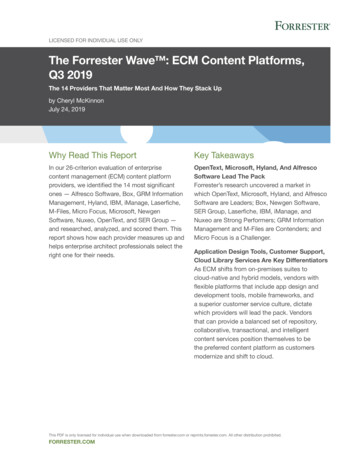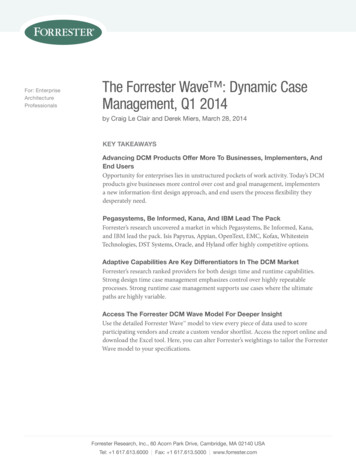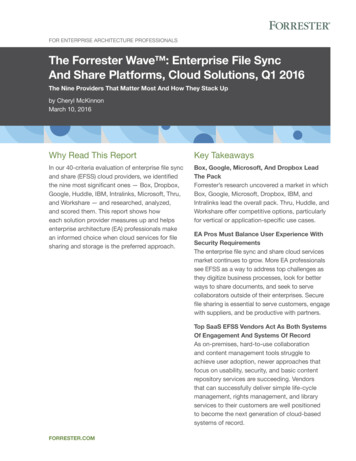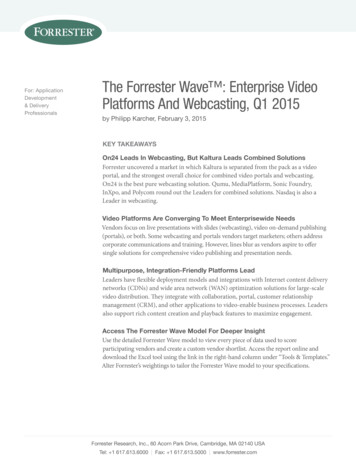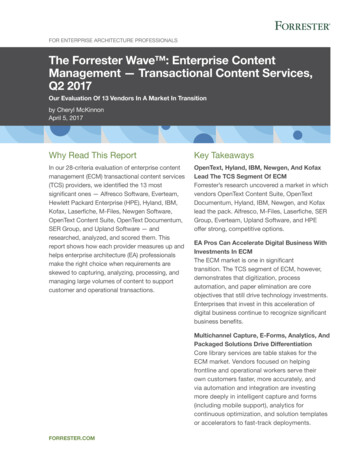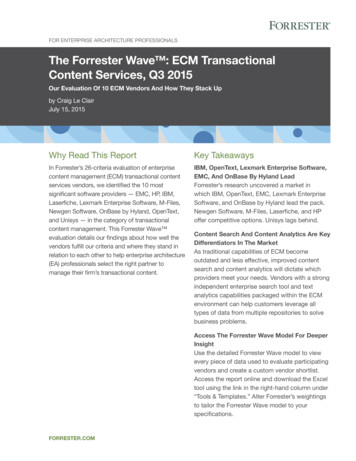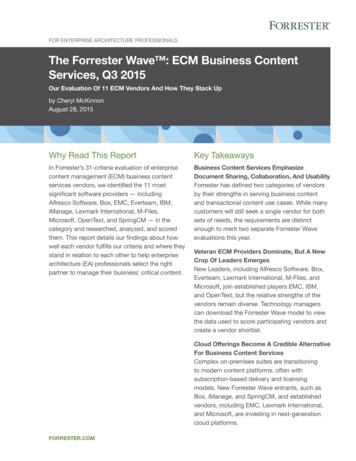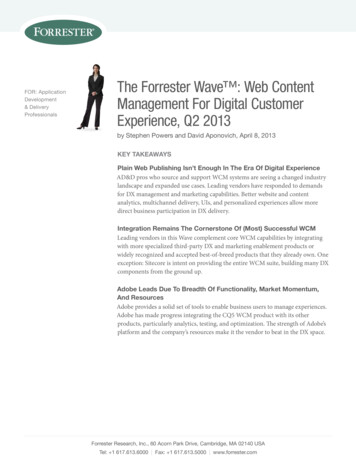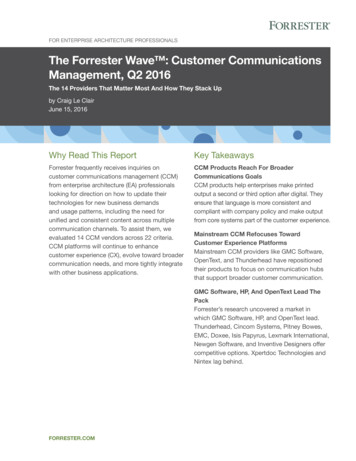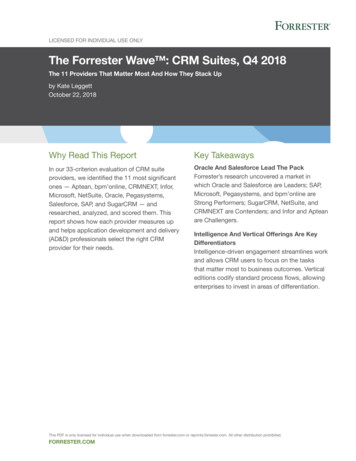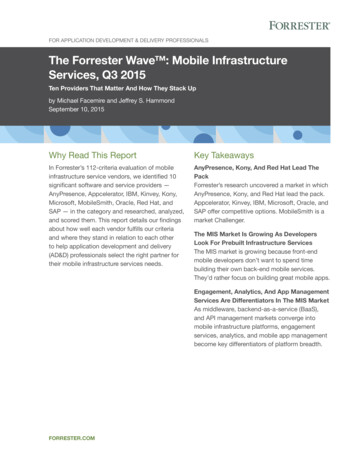
Transcription
For Application Development & Delivery ProfessionalsThe Forrester Wave : Mobile InfrastructureServices, Q3 2015Ten Providers That Matter And How They Stack Upby Michael Facemire and Jeffrey S. HammondSeptember 10, 2015Why Read This ReportKey TakeawaysIn Forrester’s 112-criteria evaluation of mobileinfrastructure service vendors, we identified 10significant software and service providers —AnyPresence, Appcelerator, IBM, Kinvey, Kony,Microsoft, MobileSmith, Oracle, Red Hat, andSAP — in the category and researched, analyzed,and scored them. This report details our findingsabout how well each vendor fulfills our criteriaand where they stand in relation to each otherto help application development and delivery(AD&D) professionals select the right partner fortheir mobile infrastructure services needs.AnyPresence, Kony, And Red Hat Lead ThePackForrester’s research uncovered a market in whichAnyPresence, Kony, and Red Hat lead the pack.Appcelerator, Kinvey, IBM, Microsoft, Oracle, andSAP offer competitive options. MobileSmith is amarket Challenger.The MIS Market Is Growing As DevelopersLook For Prebuilt Infrastructure ServicesThe MIS market is growing because front-endmobile developers don’t want to spend timebuilding their own back-end mobile services.They’d rather focus on building great mobile apps.Engagement, Analytics, And App ManagementServices Are Differentiators In The MIS MarketAs middleware, backend-as-a-service (BaaS),and API management markets converge intomobile infrastructure platforms, engagementservices, analytics, and mobile app managementbecome key differentiators of platform breadth.forrester.com
For Application Development & Delivery ProfessionalsThe Forrester Wave : Mobile Infrastructure Services, Q3 2015Ten Providers That Matter And How They Stack Upby Michael Facemire and Jeffrey S. Hammondwith Christopher Mines, Dominique Whittaker, Claudia Tajima, and Tyler ThurstonSeptember 10, 2015Table Of Contents2 Infrastructure Services Speed The MobileMind Shift5 Mobile Infrastructure Services EvaluationOverviewThe Strongest Current Offerings SupportSeven Types Of Mobile Infrastructure ServicesEvaluated Vendors Broadly Support MobileInfrastructure Services8 Converging Services Drive The MIS Market,But Capability Gaps RemainNotes & ResourcesForrester conducted detailed product evaluationsin May 2015 and interviewed 10 vendor companiesand multiple customer references for each:AnyPresence, Appcelerator, IBM, Kinvey, Kony,Microsoft, MobileSmith, Oracle, Red Hat, and SAP.Related Research DocumentsBrief: Mobile Middleware — Right Or Wrong?Brief: Services Supplant Mobile MiddlewareChoose The Right Mobile Development SolutionsCloud Mobile Development: Enabled By BackEnd-As-A-Service, Mobile’s New Middleware11 Vendor ProfilesLeadersStrong PerformersMarket Overview: Mobile Infrastructure ServicesAid DevelopersChallengers14 Supplemental MaterialForrester Research, Inc., 60 Acorn Park Drive, Cambridge, MA 02140 USA 1 617-613-6000 Fax: 1 617-613-5000 forrester.com 2015 Forrester Research, Inc. Opinions reflect judgment at the time and are subject to change. Forrester ,Technographics , Forrester Wave, RoleView, TechRadar, and Total Economic Impact are trademarks of ForresterResearch, Inc. All other trademarks are the property of their respective companies. Unauthorized copying ordistributing is a violation of copyright law. Citations@forrester.com or 1 866-367-7378
For Application Development & Delivery ProfessionalsSeptember 10, 2015The Forrester Wave : Mobile Infrastructure Services, Q3 2015Ten Providers That Matter And How They Stack UpInfrastructure Services Speed The Mobile Mind ShiftInvestment in custom-built mobile apps is growing, including both customer-facing and enterprisemobile apps. In Forrester’s Business Technographics Global Developer Survey, 2015, we see that41% of developers have worked with mobile or mobile web apps in the past 24 months, a substantialjump from 31% in 2014 (see Figure 1).Business leaders are putting a high priority on rolling out new mobile products and services to supportcustomers and employees as they embrace the mobile mind shift, and developers are doing their bestto respond.1 But building mobile apps presents a daunting challenge: Demands for faster updates andtighter integrations to existing systems of record pressure developers to build more capabilities, faster.And it doesn’t help when they are building the same app multiple times for iOS and Android, whileWindows 10 looms on the horizon. In client inquiries, it’s a common refrain that mobile developmentteams are looking to do more and work smarter without breaking budgets. That’s why cross-platformmobile solutions remain on developers’ wish lists, despite their skepticism about the ultimate fidelity ofapp engagement and concerns over capital costs.But a compromise is emerging in leading development shops, where development teams acquirecross-platform mobile infrastructure services that don’t proscribe any particular front-end mobiletechnology. In this way, teams that insist on a native app approach can still use the same servicesas teams building apps using HTML5 technologies like Apache Cordova and Sencha or teams usingcross-platform tools like Facebook React Native or Xamarin. In response, we see providers from atleast five different directions expanding their product offerings to meet the needs of front-end mobiledevelopers for timesaving mobile infrastructure services (see Figure 2).There are dozens of vendors jockeying to provide developers mobile infrastructure software orservices. We’ve analyzed 10 leading vendors that offer multiple types of mobile infrastructure servicesto shorten the decision cycle for application development pros. While we think that best-of-breedmobile specialists will remain an important part of this market for the near future, we also expect moredevelopment shops to look to consolidate their mobile infrastructure services with a smaller set ofsuppliers or a single supplier when practical and cost-effective. 2015 Forrester Research, Inc. Unauthorized copying or distributing is a violation of copyright law.Citations@forrester.com or 1 866-367-73782
For Application Development & Delivery ProfessionalsSeptember 10, 2015The Forrester Wave : Mobile Infrastructure Services, Q3 2015Ten Providers That Matter And How They Stack UpFIGURE 1 More Developers Are Building Mobile Apps And Mobile Websites“Which of the following types of development technologieshave you worked with in the past 24 months?”60%64%Websites or web applications31%Mobile or mobile web appsRich client/client-server appsCloud computing/elastic applications20142015*41%27%28%25%35%Base: 1,716 global developers*Base: 1,943 global developers(multiple responses accepted)Source: Forrester’s Business Technographics Global Developer Survey, 2014*Source: Forrester’s Business Technographics Global Developer Survey, 2015 2015 Forrester Research, Inc. Unauthorized copying or distributing is a violation of copyright law.Citations@forrester.com or 1 866-367-73783
For Application Development & Delivery ProfessionalsSeptember 10, 2015The Forrester Wave : Mobile Infrastructure Services, Q3 2015Ten Providers That Matter And How They Stack UpFIGURE 2 Multiple Markets Converge To Provide Infrastructure ServicesVendor categoryMarket entry tacticsVendor examplesMobile backend-as- Add on-premises capabilities to on-demand services Kinveya-service (MBaaS)Red Hat Broaden services to include specialist featuresAnyPresence(e.g., analytics, notification)Mobile middleware Separate front-end tools from services Create client-side native APIs Add cloud-based deploymentKony MobileFabricIBM MobileFirst PlatformOracle Mobile Cloud ServiceAPI management Generate native mobile APIs Acquire mobile specialistsAxwayApigeeWSO2Public cloud Acquire mobile specialists, MBaaS players Extend core service investments to support mobileAmazon Web ServicesMicrosoft Azure App ServiceGoogle Cloud SaveIBM Bluemix mobile servicesMobile specialist Offer best-of-breed services Broaden services offered to expand reach Add native APIs to containerUrban AirshipSitrionAdobe Experience ManagerMoovwebOpenMarketGood TechnologyTwilio 2015 Forrester Research, Inc. Unauthorized copying or distributing is a violation of copyright law.Citations@forrester.com or 1 866-367-73784
For Application Development & Delivery ProfessionalsSeptember 10, 2015The Forrester Wave : Mobile Infrastructure Services, Q3 2015Ten Providers That Matter And How They Stack UpMobile Infrastructure Services Evaluation OverviewTo assess the state of the mobile infrastructure services market and see how the vendors stackup against each other, Forrester evaluated the strengths and weaknesses of 10 leading mobileinfrastructure services vendors, looking at the depth of their capabilities across seven classes of mobileinfrastructure services that development teams need.The Strongest Current Offerings Support Seven Types Of Mobile Infrastructure ServicesAfter examining past research, several years of client inquiries, and vendor and expert interviews, wedeveloped a comprehensive set of evaluation criteria across seven types of mobile infrastructure services.We evaluated vendors against 112 criteria related to the service types and vendors’ ability to providethem at scale now and in the future. We grouped the resulting criteria into three high-level buckets:›› Current offering. Our analysis looked for providers that showed the most balance and breadth inthe mobile infrastructure services offered. We looked for: 1) good current capabilities across seventypes of mobile infrastructure services (see Figure 3); 2) flexible delivery of mobile infrastructureservices via public cloud, on-premises, or hosted options; 3) client-side support for front-enddevelopers via software development kits (SDKs) or plug-ins that support native or hybrid appdevelopment; and 4) life-cycle management support that aids testing and staging of pre-productionapps, including gathering beta feedback.›› Strategy. To assess strategy, we examined each vendor in terms of: 1) vision — a compelling pictureof where these solutions will be in the next two to three years, what additional mobile infrastructureservices they will offer, and whether vendors are forcing market convergence or reacting to it; 2)customer satisfaction — while we expect that every vendor will be able to field customers using theplatform, we looked for examples of customers with compelling production apps deployed at scaleto get a sense of how these services could be used; 3) speed to market — in a rapidly convergingmarket that already prizes high-velocity development, we find that teams expect regular updatesthat keep up with iOS and Android client capabilities and 4) alliances — in many cases, we find thatvendors are plugging gaps in the embedded services they offer through third-party partnerships withother mobile specialists. We did not score these third-party integrations with full marks in currentoffering, as they require additional purchases, but we have acknowledged their value as part of anadaptive strategy.›› Market presence. To score market presence, we analyzed three areas: 1) client base and growthspecific to mobile infrastructure services; 2) the number of mobile apps deployed and the highestscale deployments; and 3) overall revenues and dedicated revenue from the vendors mobileinfrastructure services offerings. 2015 Forrester Research, Inc. Unauthorized copying or distributing is a violation of copyright law.Citations@forrester.com or 1 866-367-73785
For Application Development & Delivery ProfessionalsSeptember 10, 2015The Forrester Wave : Mobile Infrastructure Services, Q3 2015Ten Providers That Matter And How They Stack UpFIGURE 3 Seven Mobile Infrastructure Services That Mobile Developers NeedMIS servicesDescriptionIdentity and securityLinking individual users’ mobile identity to corporate systems is a key app builderneed. Identity services build on existing directory services while providinglightweight authentication, authorization, and accounting of what the individualusers are allowed to do.Offline data syncSynchronization of data that supports offline mobile experiences often requires astore-and-forward architecture with support for data conflict resolution.User engagementInnovative mobile apps fully engage customers by making use of devicenotifications, GPS, beacons, the accelerometer and other sensors.Analytics/APMMobile success relies on rapid user feedback. Client and server-side analytics givedevelopers an end-to-end view of an app’s performance and how it’s being used.Data/integrationConnecting to back-end systems and transforming that data into a mobileoptimized format requires a consistent, consumable API. Wrapping the APIs in aclient-side SDK that front-end developers can consume is even better.Data aggregation andbusiness logicAPIs solve data access challenges, but often mobile activities drive businessprocesses. These services allow developers to build custom business logic torestructure and aggregate data from multiple back-end systems.App managementApps can be distributed through public app stores or enterprise app stores, andneed feedback mechanisms and app management to support a full end-toend mobile development life cycle.Evaluated Vendors Broadly Support Mobile Infrastructure ServicesForrester included ten vendors in the assessment: AnyPresence, Appcelerator, IBM, Kinvey, Kony,Microsoft, MobileSmith, Red Hat, Oracle, and SAP. To determine which vendors to examine, we fielded anopen survey in March, and then reviewed the submissions of more than two dozen vendors. We selectedeach of these vendors based on their responses to survey questions. Each of these vendors (see Figure 4):›› Supports a broad range of mobile infrastructure services. We asked whether each vendorhad support for the following services types: mobile identity and security, offline client data,engagement services, analytics, connectors to enterprise systems of record, connectors to customdata sources, support for server-side execution of business logic, mobile app management, anddeployment and delivery services. Vendors that did not claim support for at least eight of thesenine service types were excluded.›› Support for hosted or public cloud deployment. One trait that separates mobile middlewaresolutions and mobile infrastructure services is the speed that developers can self-provision them.Accordingly, we eliminated any solutions that did not offer services that could be deployed in ahosted or public cloud environment. 2015 Forrester Research, Inc. Unauthorized copying or distributing is a violation of copyright law.Citations@forrester.com or 1 866-367-73786
For Application Development & Delivery ProfessionalsSeptember 10, 2015The Forrester Wave : Mobile Infrastructure Services, Q3 2015Ten Providers That Matter And How They Stack Up›› Proven customer adoption. Vendors that could not provide at least three customer referenceswere excluded. Our evaluation included interviews with contact customer references to validatetheir use of vendor solutions. Those conversations are reflected in the vendor scores.›› A generally available solution. While we recognize that the mobile infrastructure services marketis converging at the speed of light, clients need a product they can order and deploy, not beta bits.All the solutions we reviewed were generally available as of July 1, 2015.FIGURE 4 Mobile Infrastructure Services Vendor Selection CriteriaVendorProduct evaluatedAnyPresenceAnyPresence Platform, JustAPIsAppceleratorThe Appcelerator PlatformIBMIBM MobileFirst PlatformKinveyKinvey Mobile Backend-as-a-Service platformKonyKony Mobility PlatformMicrosoftAzure Mobile Services, App Service, Visual Studio,Visual Studio Online, Visual Studio 2015 PreviewMobileSmithMobileSmithOracleOracle Mobile Cloud ServiceRed HatRed Hat Mobile Application PlatformSAPSAP Hana Cloud Platform, SAP Mobile Platform, SAPMobile SecureProduct versionevaluated74.07May 201567.1415.2.331.0, 3.0 SP07,2.8Vendor inclusion criteriaVendors that currently offer generally available services in at least six of the following nine categories:identity and security, offline data services, customer engagement services, analytics, connectors toexisting systems of record and /or custom data sources, support for server-side business logic, mobileapp management, and development tools or deployment services.Vendors agree to provide up to three customer references for the purposes of gauging levels of currentcustomer satisfaction.Forrester clients demonstrate significant levels of interest in the vendor, warranting a deeperexamination of their capabilities. 2015 Forrester Research, Inc. Unauthorized copying or distributing is a violation of copyright law.Citations@forrester.com or 1 866-367-73787
For Application Development & Delivery ProfessionalsSeptember 10, 2015The Forrester Wave : Mobile Infrastructure Services, Q3 2015Ten Providers That Matter And How They Stack UpConverging Services Drive The MIS Market, But Capability Gaps RemainOur evaluation of the 10 selected vendors validates our analysis of an emerging mobile infrastructureservices market that will subsume the mobile middleware and mobile backend-as-a-service markets.Vendors from both those segments scored well by offering a broad set of headless services that canbe consumed through multiple deployment options. That said, even the strongest vendors showedsome gaps in the completeness of their offerings, especially when it comes to embedded engagementservices, analytics, and mobile app management services. There’s room for additional growth, and wesee a market where leaders are just emerging (see Figure 5):›› AnyPresence, Kony, and Red Hat carve out a narrow lead among MIS providers. Provingthe consolidation of the mobile middleware and backend-as-a-service space, we see one vendorfrom the middleware market and two from the backend-as-a-service market emerge as Leaders inthis year’s MIS Wave evaluation. Kony achieved its position through its overall breadth of offering,successfully distinguishing their front-end services from back-end services, and providing a highlydifferentiated set of development tooling. AnyPresence took a different route: Its feature set met allthe necessary criteria, but it stands out when we evaluate its strategy, including consistent platformupdates, forward-looking vision, and highly positive customer references. Red Hat has moved intothis market through acquisition of FeedHenry, and is quickly moving to connect its backend-asa-service offerings to Red Hat’s own extensive set of integration tooling, JBoss Fuse. Combined,these three vendors set the bar for mobile infrastructure services.›› Appcelerator, IBM, Kinvey, Microsoft, Oracle, and SAP are Strong Performers. IBM, Microsoft,Oracle and SAP have battled in the enterprise software space for many years, and that battlecontinues in the mobile enablement space. It’s quite a statement about the BaaS industry thatAppcelerator and Kinvey join them as Strong Performers in the MIS Wave evaluation. Each of thesevendors is strong across the major mobile infrastructure disciplines — the biggest differentiator inthe group is market presence. We expect this to normalize as awareness increases and existingcustomers expand their usage of the product. Our analysis shows that each of these vendorswould be well suited to act as the centerpiece of nearly all enterprise mobility solutions.›› MobileSmith challenges by focusing on the needs of low-code developers. MobileSmithsucceeds in being a low-code, rapid mobile app builder that leverages existing REST APIs toexpose back-end data. This focus on rapid development and ease of use for business developersand non-developers alike limits them in this assessment of broad, headless mobile infrastructureservices. That said, clients looking for a tool to quickly generate functional mobile apps shouldn’toverlook MobileSmith. Baseline capabilities exist in nearly all of the key enterprise mobilitycategories that Forrester investigates, but strength in any one of them isn’t core to MobileSmith’ssuccess criteria, thus establishing them as a Challenger in today’s market.This evaluation of the mobile infrastructure services market is intended to be a starting point only.We encourage clients to view detailed product evaluations and adapt criteria weightings to fit theirindividual needs through the Forrester Wave Excel-based vendor comparison tool. 2015 Forrester Research, Inc. Unauthorized copying or distributing is a violation of copyright law.Citations@forrester.com or 1 866-367-73788
For Application Development & Delivery ProfessionalsSeptember 10, 2015The Forrester Wave : Mobile Infrastructure Services, Q3 2015Ten Providers That Matter And How They Stack UpFIGURE 5 The Forrester Wave : Mobile Infrastructure Services Q3 2015Challengers racleKinveyMicrosoftAppceleratorRed HatAnyPresenceGo to Forrester.com todownload the ForresterWave tool for moredetailed productevaluations, featurecomparisons, andcustomizable rankings.CurrentofferingMobileSmithMarket presenceWeakWeakStrategyStrong 2015 Forrester Research, Inc. Unauthorized copying or distributing is a violation of copyright law.Citations@forrester.com or 1 866-367-73789
For Application Development & Delivery ProfessionalsSeptember 10, 2015The Forrester Wave : Mobile Infrastructure Services, Q3 2015Ten Providers That Matter And How They Stack KinveyKonyMicrosoftMobileSmithOracleRed HatSAPFIGURE 5 The Forrester Wave : Mobile Infrastructure Services Q3 2015 (Cont.)CURRENT OFFERINGIdentity and security servicesData and offline accessEngagement servicesAnalyticsIntegration/data connectorsBusiness logicApp managementDeploymentClient-side developmentQuality/life cycle 02.954.855.004.505.002.752.50STRATEGYPlatform updatesSimultaneous updateVisionAlliancesCustomer 5.001.004.003.00MARKET PRESENCETotal vendor revenue from all sourcesVendor revenue percentageInstalled baseAppsNet 005.005.001.001.00All scores are based on a scale of 0 (weak) to 5 (strong). 2015 Forrester Research, Inc. Unauthorized copying or distributing is a violation of copyright law.Citations@forrester.com or 1 866-367-737810
For Application Development & Delivery ProfessionalsSeptember 10, 2015The Forrester Wave : Mobile Infrastructure Services, Q3 2015Ten Providers That Matter And How They Stack UpVendor ProfilesLeaders›› AnyPresence. AnyPresence is a market Leader in mobile infrastructure services due to strength inthe core disciplines of the space, current customers that cannot find enough good things to say,and a vision for the future that will not disrupt today’s success. AnyPresence was an early entrantinto the backend-as-a-service market, yet created a unique offering in that the product isn’t a BaaSitself, but instead creates BaaS instances based on customer requirements. This model affordsflexibility in core areas like enterprise data connectivity, a robust business logic platform, and afrequent platform update schedule for both cloud and on-premises deployments. This also fuels itsvision going forward to play in today’s B2E and B2C markets, while allowing AnyPresence to be aLeader in the burgeoning B2B2C market.›› Kony. Kony is a market Leader in mobile infrastructure services due to its multiyear re-engineeringeffort that separated the KonyOne mobile middleware solution into separate front-end design toolsand services for back-end data access (Kony MobileFabric). This reflects in the Wave with strengthin both enterprise data access and robust offline data support along with front-end strength inengagement and identity services. Rarely is the topic of “enterprise middleware” accompaniedby “intuitive design tools,” but the Kony Visualizer sets the standard here. Tying this all togetheris a solid set of business partners that help Kony fill nearly all needs in the mobile softwaredevelopment life cycle.›› Red Hat. Red Hat is a newcomer to the mobile infrastructure services space, but FeedHenry, theindependent software vendor (ISV) it acquired to jump into enterprise mobility, is far from an entrylevel product. FeedHenry was well-known in Europe pre-acquisition — living under the Red Hatumbrella will help grow that awareness worldwide. In doing so, Red Hat will be promoting strengthsin enterprise data connectivity, offline synchronization, and an outstanding vision for the future ofthe product that is exciting many clients that we spoke to. One concern, as with any acquisition, ishow the parent company may affect the current product direction. Forrester will keep a close eyeon this and provide updates here as needed. We’d also advise prospective adopters to invest indevelopers with experience and strong skills in Node.js, as it will maximize their investments in RedHat’s platform.Strong Performers›› Appcelerator. Appcelerator’s strength is driven by a vibrant history within the mobile developmentcommunity. Many are aware of the Titanium development studio and multiplatform developmenttool. Working with this development community allowed it to identify common front-end needs forback-end services, leading to the creation of the Appcelerator platform. MIS services include solidapp identity and security, engagement, and app deployment services, combined with rapid, regularupdates to the overall platform. 2015 Forrester Research, Inc. Unauthorized copying or distributing is a violation of copyright law.Citations@forrester.com or 1 866-367-737811
For Application Development & Delivery ProfessionalsSeptember 10, 2015The Forrester Wave : Mobile Infrastructure Services, Q3 2015Ten Providers That Matter And How They Stack Up›› IBM MobileFirst Platform. IBM’s approach to mobile middleware is similar to that of its suite ofmiddleware products — attack with a broad market offering backed by a well-known servicesorganization. This places IBM squarely within the group of strong mobile infrastructure servicesperformers. IBM continues to hone the technique of seeing a market need, acquiring solid playersto fill parts of that need, and then bringing them together under one blue roof for their establishedcustomer set. Look no further than its current offering to see this evolution in mobile — onlyone vendor finished stronger when comparing the full set of current platform features. In 2016and beyond, we expect to see IBM’s pace of innovation pick up as it finishes consolidating itsacquisitions and fully moving them onto self-provisioning, public cloud infrastructure.›› Kinvey. Kinvey pioneered the backend-as-a-service market.2 As BaaS evolved to encompass APImanagement functionality and grew to be a viable alternative to the mobile middleware space,Kinvey evolved as well. It embraced the need for robust enterprise data access, added deploymentoptions that span many varieties of hybrid, and provided a modern Node.js-based business logicplatform that supports any number of corporate use cases. These investments, along with acontinuous, consistent schedule of updating both the hosted and on-premises deployments land itsquarely as a Strong Performer in this Wave evaluation.›› Microsoft. Microsoft embodies the new model of mobile infrastructure services. Instead ofa single product that addresses the full suite of enterprise needs, it offers a loosely coupledcollection of services built on Azure that companies can choreograph into a tailored solution. Thisallows Microsoft to leverage Azure’s strengths in identity and security services, enterprise dataconnectivity, offline support, and analytics to make it a Strong Performer in the mobile infrastructureservices space. While critics focus on its inability to break into the mobile client hardware space, itsinvestment in the back end of mobile solutions delighted the customers that we spoke with, makingits MIS strategy a pillar for future success.›› Oracle Mobile Cloud Service. Oracle’s Mobile Cloud Service (MCS) is the newest product in thisWave evaluation (released for general availability in June 2015), but it’s far from new to the mobilegame. MCS is much more than a simple “cloudwashing” of their previous product, ADF Mobile.When ADF Mobile struggled to get market traction, Oracle went back to the drawing board, lookedat the current challenges facing companies building mobile apps, and built MCS. While Oracleplaced on the low end of the Strong Performer range in our evaluation, we expect its positionto strengthen in the future, as current offering scores were limited by a lack of live customerdeployments at scale paired with below-average analytics, engagement services, and client-sidedevelopment feature sets. These are all functional areas that Oracle has on the near-term productroad map
AnyPresence, Kony, And red Hat Lead The Pack Forrester’s research uncovered a market in which Anypresence, Kony, and red Hat lead the pack. Appcelerator, Kinvey, iBM, Microsoft, oracle, and SAp offer competitive options. MobileSmith is a market challenger. The MIS Market Is Growin

